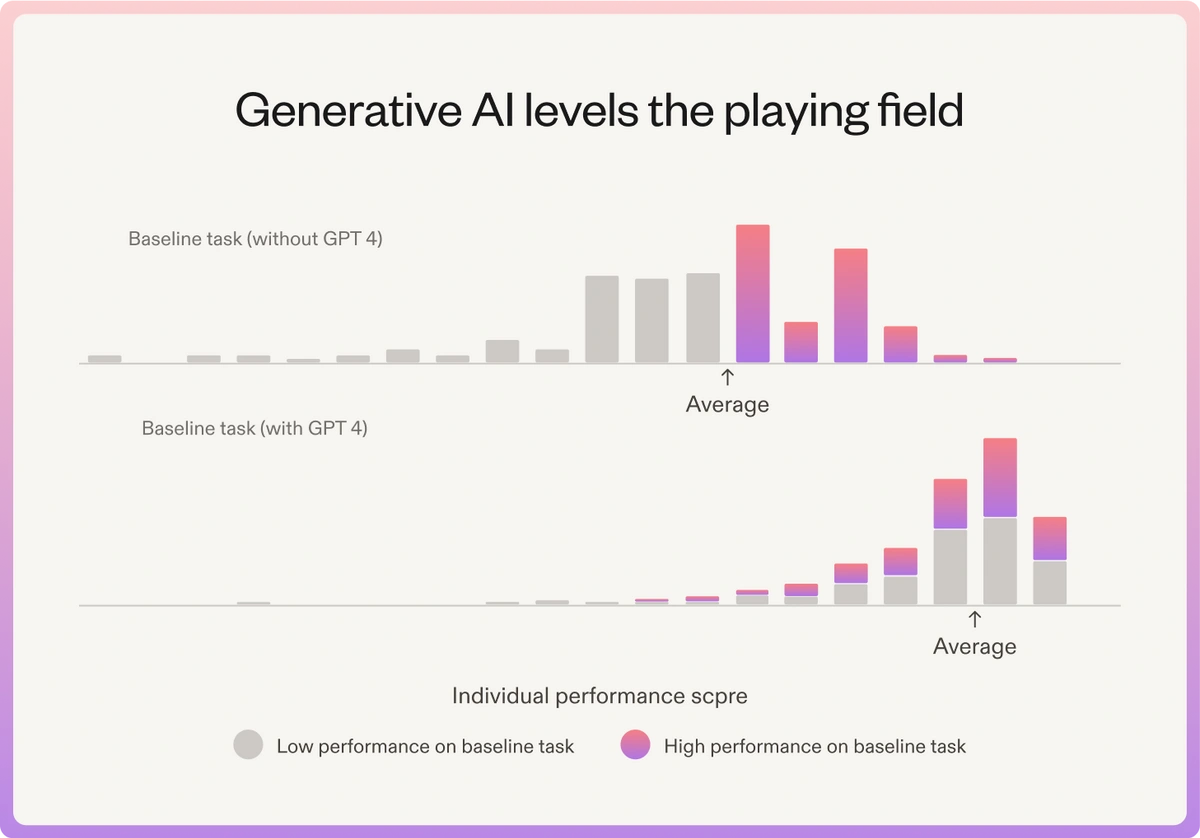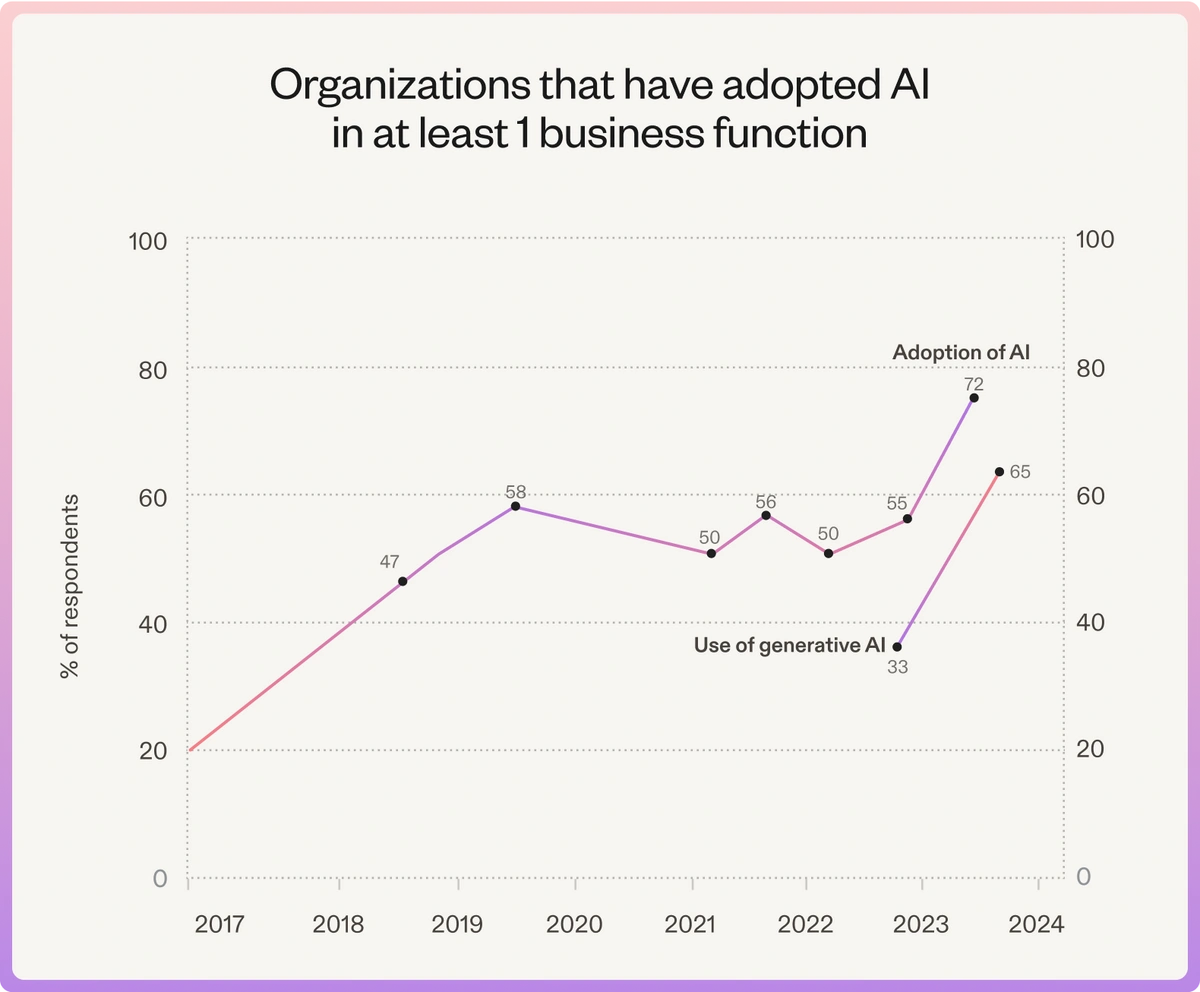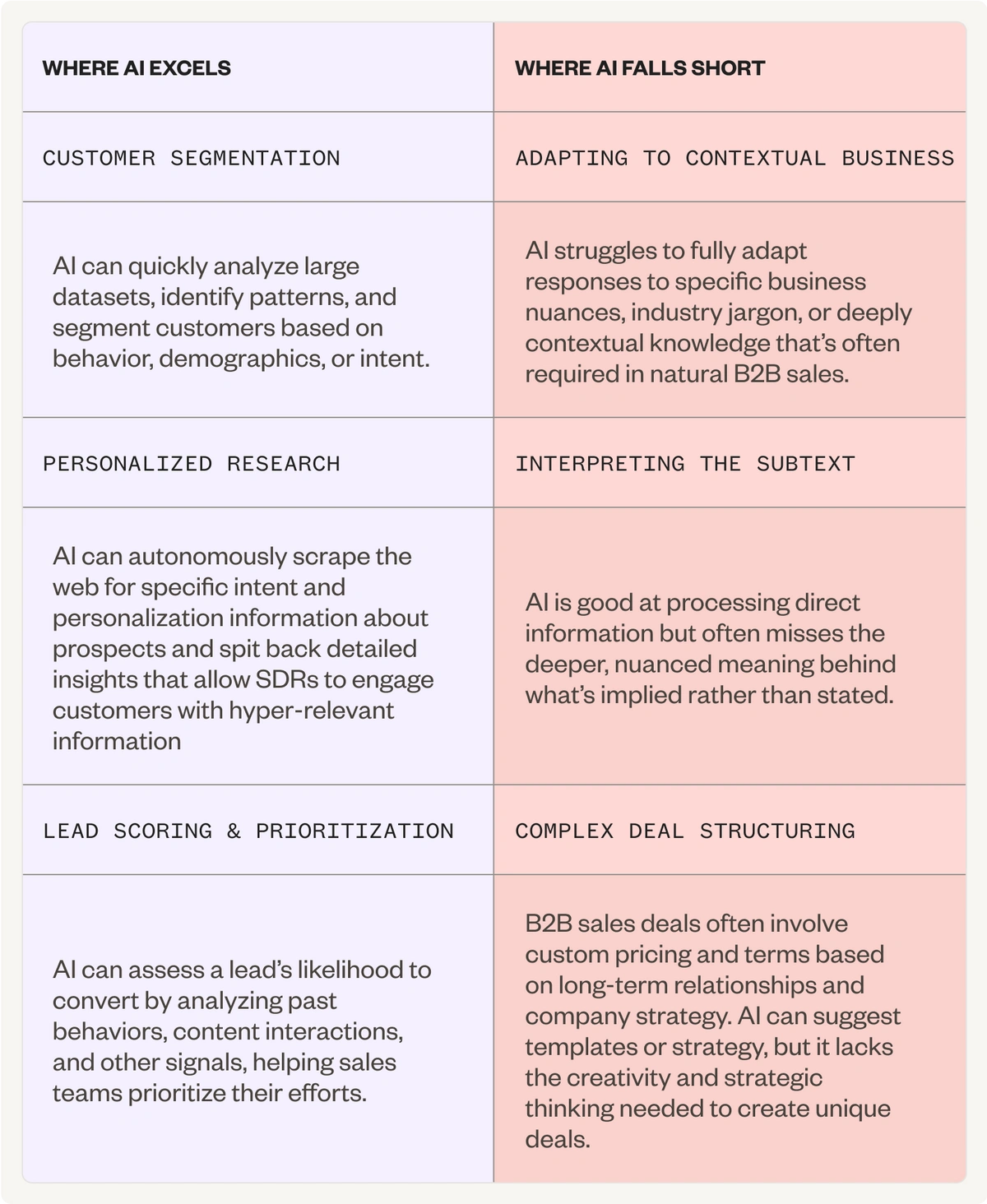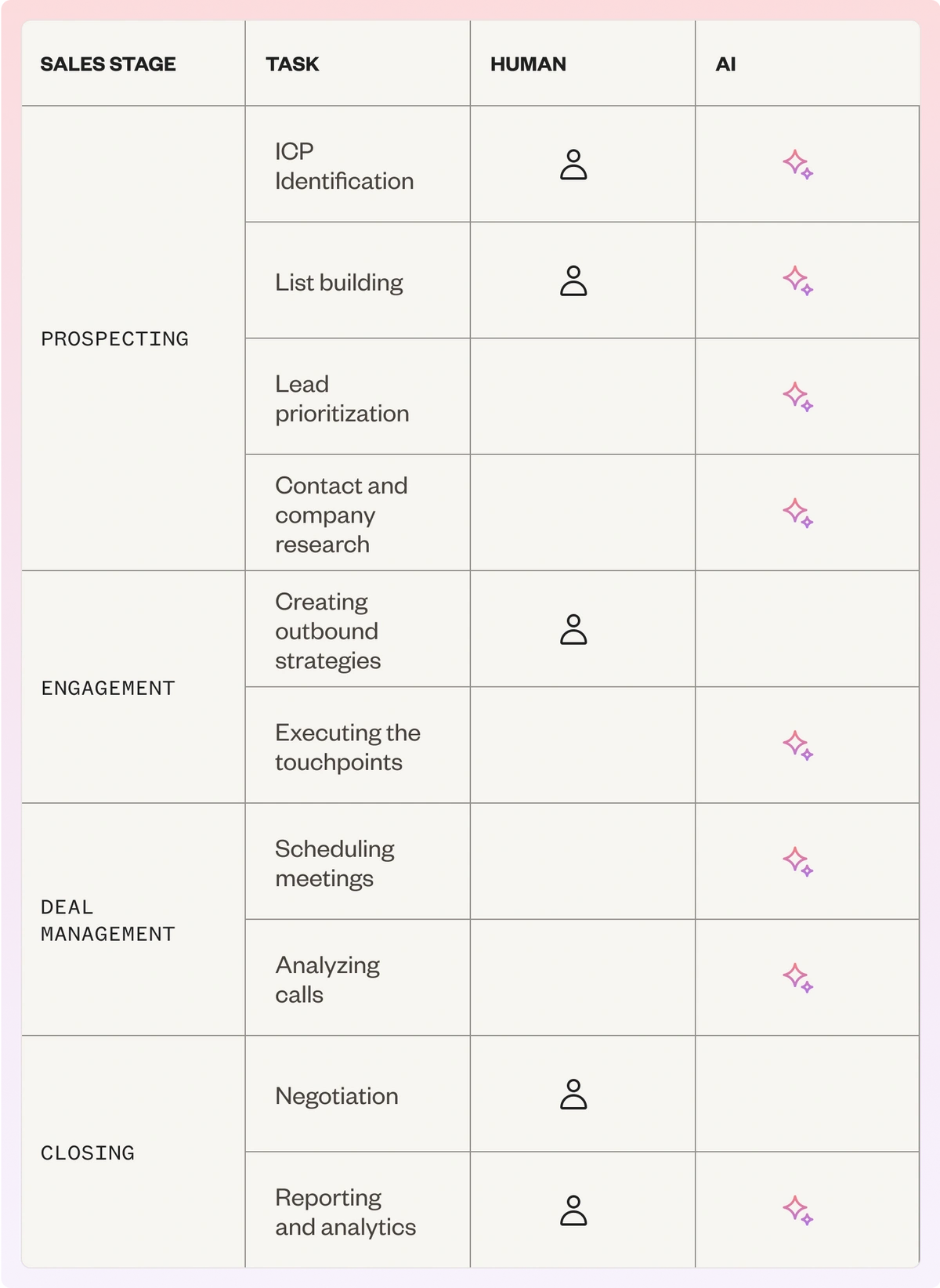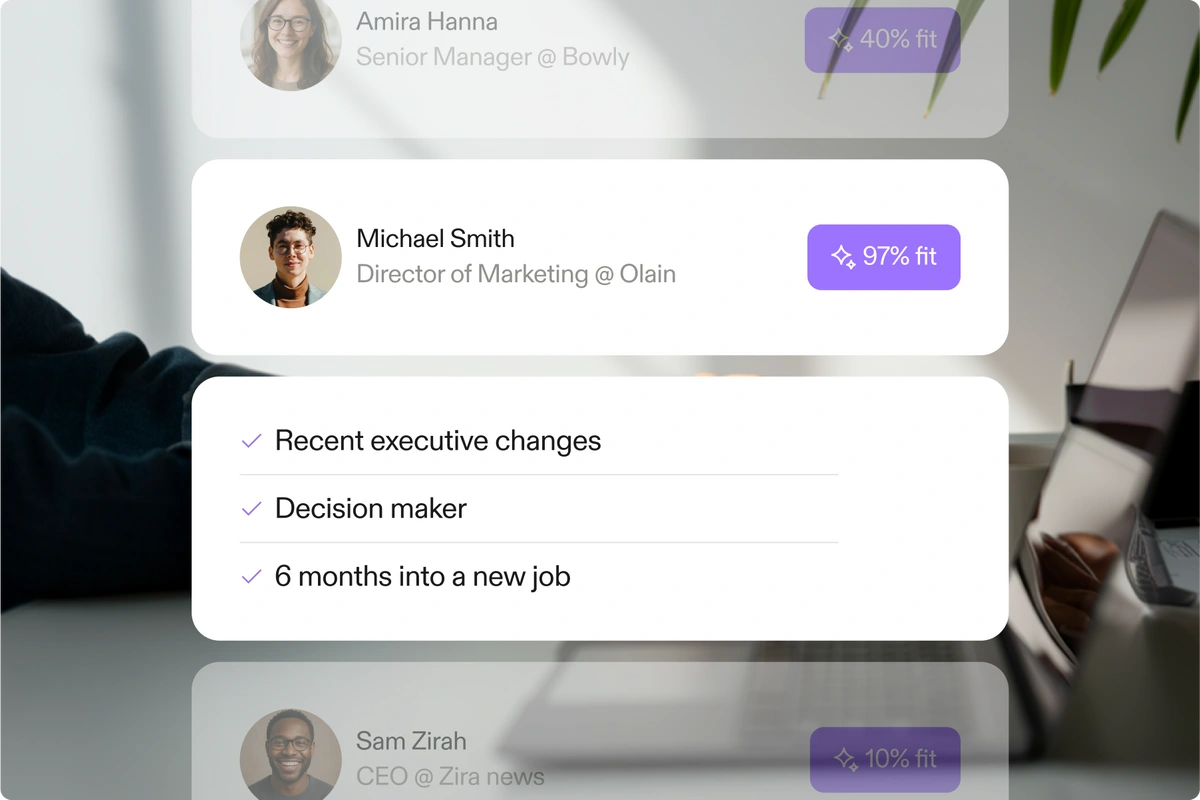The State of AI in Sales in 2025
AI is changing how sales works—but is it working for you? In part one of our power-packed series on AI, we map out the entire sales funnel to show you where artificial intelligence is uniquely equipped to give you an edge in 2025. Learn how to automate what you should, humanize what you must, and leverage the right tools to do it.
by
Karli Stone
PUBLISHED May 5, 2025
8 Min Read
The strange thing about revolutions is that you often don't notice when you're in the middle of them.
Consider the iPhone.
When it first came out, I was in 7th grade and I distinctly remember thinking it wasn't that big of a deal. (Even investors felt the same — one even called it "dead on arrival".)
But within weeks, my classmates started showing up with them. Then my mom. Then me. At some point, that sleek little gadget stopped being a novelty and became a default. Most of us now think in "iOS" — calendars, maps, messages, ideas — all neatly organized in our pockets.
Tech movements don't always start with fireworks. They unfold, one small shift at a time, until suddenly everything feels different.
AI in sales is going through the same transformation. And, for you — as business owners and people leaders and commission-earners — the stakes are much higher than middle school peer pressure. Because, we're far past the "release of the iPhone" stage of AI.
Sales teams using AI are 25% more likely to see revenue growth than those who aren't. The once-blurry picture of AI's potential is coming into focus; the money is following.
"AI is going to be critical to humanity," says the tech analyst who saw the iPhone wave coming before most.
Those paying attention early are the ones who get ahead, and you're one of them.
So what exactly is AI doing in sales today? And where can you best leverage it?
The 3 truths about AI in sales today
Truth #1: If it sounds too good to be true — it probably is
Growing up, my siblings and I would stake our claim on communal treats by licking the ones we wanted to save for later. Gross? Definitely. But it proved to be effective at preventing anyone else from snatching our germy cookies before we could.
I noticed that tech companies are doing something equally immature with AI.
They hastily embed some version of OpenAI into their product, rush it to market, and slap a big, fat "[Company Name] AI" sticker on it; all for the sake of shouting, "This is ours! Look at us! We're in the club!"
But, our team ran a survey, and found that half of all sales leaders aren't satisfied with any of the AI tools on the market — it's just a whole lot of soggy cookies.
Which puts the pressure on sales leaders to make an AI investment that's:
- Broadly adoptable and scaleable within their current process
- Offers clear ROI
- And has a measurable impact
Truth #2: Generative AI is a leveler of performance
A study from a group of scholars at Harvard, MIT, and Wharton flips the entire "Human vs. Robot" argument on its head.
Essentially, it found that the use of generative AI has two major effects on the workforce:
- It improves performance. 90% of participants, irrespective of their baseline proficiency, produced better results when using GPT-4 for creative or product-related tasks.
- The gap between top and lower performers is reduced. A higher share of participants performed at or very close to the average level. AI pulls these averages up across the board.
Gen AI is creating brand new opportunities for human talent.
This has incredible implications for sales, an industry that's been historically hampered by big experience gaps and steep learning curves for fledgling SDRs.
"I think there is a lot of value added in what we can do as humans," one study participant was quoted as saying, "[Now] you need a human to adapt an answer to a business's context; that process cannot be replaced by AI."
Truth #3: AI excels in some areas — but not all
In 2025, AI is assisting in life-saving surgeries.
It's reimagining the way we grow our food and tracking your teeth brushing habits. It's even "resurrecting" your loved ones with text and voice language models.
The creative applications of AI are endless, beyond sales, but within it, too.
65% of organizations are regularly using gen AI — nearly double the percentage from their previous survey just ten months ago.
But are they applying it in the right place?
The same research article out of Harvard summarized its findings like this:
"The job of the leader is to help people use the new technology in the right way, for the right tasks and to continually adjust and adapt in the face of GenAI's ever-expanding frontier."
So, what are these "right" sales tasks, and how do we define them in the context of generative AI?
What is generative AI in sales?
When people refer to "generative AI" in sales, they're talking about using artificial intelligence tools to autonomously create content, insights, and solutions that enhance sales processes and drive better outcomes. That includes everything from writing prospecting emails to forecasting deals and prioritizing leads.
Generative AI is incredible at some of these things — but it has its limits.
The proven ROI of AI in sales
Let's cut to the chase: AI isn't just a shiny new toy. It's a revenue engine. Teams that embed AI into their sales process aren't just keeping up; they're pulling away from the pack. Why? Because AI delivers tangible returns by transforming efficiency into dollars.
Think about the hours your reps spend on manual research, list building, and writing first-draft emails. AI automates that grunt work, freeing them up to do what they do best: build relationships and close deals. This leads directly to more pipeline, shorter sales cycles, and higher win rates. It's not about replacing reps; it's about making your best reps even better and giving your entire team the tools to perform at a higher level. The investment isn't in the tech itself, but in the measurable growth it unlocks.
Man vs. Machine: What's AI's job and what's yours?
Look closely and you'll find a common thread.
Segmentation, lead scoring, research, and copywriting; right now, artificial intelligence is ripe for outbound sales.
This shift means we need to rethink where humans add the most value, not with fear but with curiosity. The focus is moving from brute-force execution to strategy, testing, and orchestration. In short: less doing, more designing.
So, what does this new dance between human and machine actually look like in practice? Before I explain the "how", here's a cheatsheet.
Prospecting
Targeting your ICP
Figuring out who your ideal customer is the first step of selling anything. It demands an intimate and involved understanding of your business that a machine can't replicate.
Using your deep contextual knowledge around what you sell and who you help, build out your buying personas and determine the best search filters to apply to your contact database. As you start to perform prospecting activities (in a modern sales tool that tracks that kind of thing), AI can help you analyze huge datasets on what type of person engaging, converting, and ultimately buying. This means that now, your targeting is actively improving the more you sell. It becomes a feedback loop that helps you continuously refine your personas, adjust your filters, and double down on the segments that show traction.
| Conclusion: It's a task that starts with human contextual knowledge and ends with a machine's ability to scale it. |
List building
Pulling the leads you find into a workable list requires some minimal human action, but, once you have your ICPs built out with all your filters, you can save and subscribe to your searches.
Apollo will run in the background to help you auto-populate your lists with new leads that fit your criteria.
| This is a job for humans with the support of automation. |
Lead prioritization
According to the Pareto Principle, 80% of your revenue comes from the top 20% of your accounts.
AI is capable of weeding through entire lead lists to help you identify which prospects mirror these "top 20%" accounts, when they are most likely to buy, and if that time is now.
In Apollo, for example, this is called Scores. It works right out of the box (AI automatically generates scores based on your account and prospecting activity. The more you do, the more it learns) and it essentially takes the entire task of lead prioritization off of the human SDR's plate.
| The takeaway? AI can handle this one. |
Contact and company research
Research is the crème de la crème. The zenith. The apex of AI's brilliance!
With the right prompt, AI can comb company websites, LinkedIn activity, press releases, portfolios, social media posts, YouTube — everything available on the world wide web! — to give you insights that would previously take hours to gather in a matter of minutes.
Today, sales systems and tools that have built-in AI prompting help salespeople in two key ways.
- Lead segmentation. For example, if you sell apparel to fashion distributors, you can ask AI to find and filter out companies who sell multiple brands on their website to give you a more refined list.
- Messaging personalization. You can funnel research insights directly into your email that personalizes it for each individual account or person: "Hi [Prospect Name], I see that your website currently features multiple brands like [Brand 1], [Brand 2], and [Brand 3]."
| It's not a question. This is where you apply AI. |
Engagement
Building your outbound strategies
When you should email, what you should say, when to hop on a call, and to whom, is decided by you — to an extent.
If you're starting from scratch, it's a matter of choosing a specific ICP, building a sales sequence, adjusting, testing, and seeing what works. But this isn't to say you're shooting in the dark.
The content of your emails can be auto-personalized and populated with snippets and the results of AI prompting. And the data that flows into these sequences can be auto-enriched and auto-prospected on a schedule determined by you.
| It's the job of a human who's informed by AI + Automation (and pre-built templates! Templates are good!) |
Executing the touchpoints
After you build your outbound structure, all the work can flow…like…in a Workflow.
Workflows are the end-to-end automations that execute the sequence enrollments, email sends, LinkedIn touchpoints, manual task assignments, follow-ups, triggers, and notifications — it's the orchestrator of your outbound.
It's the most powerful (and profitable) use case for automation across the entire sales funnel.
| In case it wasn't obvious, automation wins here. |
Deal Management
Scheduling meetings
When I think of stellar automation at the bottom-of-the-funnel, the sales team at Cyera comes to mind. They used a combination of tools, including Apollo Meetings, to cut their BDRs' manual work in half.
It's possible for you, too, with a bit of initial setup.
Connect your calendar, set your default availability, add relevant stakeholders from your team, and send out the link. From here, Apollo handles automatic email reminders, notes, and even the good, insightful stuff like auto-generated reports after the meeting is done.
| The jury (of me) is in: Automate this |
Analyzing sales calls
AI-powered dialers are one of the longest-standing use cases of AI in the space — and for good reason.
Industry research from Gong shows that you can increase win rates by more than 26% if you use AI to pull key takeaways and next steps from your sales calls.
You can play and share your recordings, create video clips, and take action on tasks with automatic transcripts and AI-written summaries. And as a team leader, you have everything in front of you, instantly, to coach, train, and lead teams to increase call conversions.
| Conclusion: Use AI here |
👉 Watch this free course on Apollo Conversations to learn best practices for AI-powered calling in 2025
Closing
Negotiation
Yeah, you're not getting out of this one…
But that's the beauty of AI and automation; it gives you the time, ability, and insights to do the real people work of meeting prospects where they are at, addressing their concerns, and leading conversations that close.
| Negotiation requires emotional intelligence, empathy, and quick thinking — that means you, human! |
Reporting and analytics
We're at a point where compiling reports by hand is not only time consuming, but less accurate.
AI can make recommendations and adjustments for you that are based on your sales activities, data, and results.
- Machine learning algorithms analyze large datasets to identify patterns and correlations between customer data and sales outcomes
- Natural Language Processing (NLP) interprets customer feedback and pulls insights from text for you
- And predictive modeling can look at historical data to predict future customer behavior and potential opportunities
| Let AI compile and digest your reports. |
If you made it this far, it's safe to assume you're interested in improving the whole of your outbound process.
Last year, my team and I wrote the book on Outbound Sales. It gives you data-backed practices for literally building your outbound process from the ground up. 👉 You can read it on the Apollo Academy for free. Or, if you're more of a pages person, you can order a copy on Amazon and Amazon Kindle.
AI sales tools: Choosing the right platform for your team
The market is flooded with tools claiming to be "AI-powered." So how do you choose the right one? The key isn't to find a tool for every single task. That just creates a messy, expensive tech stack that no one actually uses. The smartest move is to find a single, end-to-end platform that unifies your entire go-to-market strategy.
Look for a solution that combines three critical components: a massive, accurate B2B database, intelligent automation for prospecting and outreach, and seamless integration that brings all your sales activities into one command center. A true AI sales platform doesn't just automate tasks; it provides insights that help you make smarter decisions. It should help you find your ideal customers, tell you who to prioritize, and even help you write the message that gets a reply. Don't settle for a point solution when you can have a complete system.
Getting started: Your AI implementation roadmap
Adopting AI doesn't have to be a massive, company-wide overhaul. The best approach is to start smart and scale fast. Here's a simple roadmap to get you going:
- Identify one key pain point. Where is your team losing the most time? Is it research? Writing emails? Lead prioritization? Start there.
- Run a pilot program. Choose a small, motivated group of reps to test a new AI-driven workflow. This lets you learn and iterate without disrupting your entire floor.
- Measure everything. Track key metrics like time saved, meetings booked, and reply rates. You need clear data to prove the value and build a business case for a wider rollout.
- Scale what works. Once you have a proven workflow and positive results, expand the program to the rest of the team. Provide clear training and share the success stories from your pilot group to get everyone excited.
The future of AI in sales
The sales teams who win in the next decade won't be the ones who simply do more; they'll be the ones who design better systems. The revolution isn't about replacing human intuition, but augmenting it with intelligent automation. AI will handle the repetitive, data-heavy tasks, freeing up sellers to focus on strategy, creativity, and building genuine human connections.
Frequently asked questions about AI in sales
Which AI tool is best for sales?
The best AI tool isn't a single-task gadget; it's a comprehensive platform that integrates data, engagement, and intelligence. Instead of asking which tool is best, ask which platform can manage your entire workflow—from finding leads with a robust B2B database to engaging them with automated, personalized sequences. A unified solution like Apollo eliminates the need for a fragmented tech stack, giving you a single source of truth to drive your entire sales motion.
Will AI replace B2B sales?
No, AI won't replace great B2B salespeople. It will make them better. AI is designed to handle the repetitive, time-consuming tasks that bog reps down, like manual research and data entry. This frees them up to focus on high-value activities that require a human touch: building relationships, understanding complex customer needs, and strategic negotiation. AI is a co-pilot, not the pilot.
How can AI make me a better sales rep?
AI acts as your personal research assistant and strategist. It can instantly analyze a prospect's company, find relevant buying signals, and suggest personalized messaging, helping you craft outreach that resonates. It also prioritizes your leads, so you're always focused on the accounts most likely to convert. By handling the prep work, AI allows you to walk into every conversation better informed and more prepared to win.
What does the future hold for AI in sales?
The future of AI in sales is about creating fully autonomous, end-to-end GTM motions. Imagine defining your ideal customer and letting an AI-powered system identify them, engage them with personalized outreach across multiple channels, and book a meeting on your calendar—all without manual intervention. The focus will shift from reps executing tasks to reps designing and overseeing these intelligent systems.
How much should I expect to invest in AI sales tools?
Investment can vary, but the smartest approach is to focus on value, not just price. A fragmented stack of single-purpose tools can quickly become more expensive and less effective than a single, all-in-one platform. Look for a solution that consolidates your data, prospecting, and engagement tools. This not only reduces your total cost of ownership but also provides a much higher ROI by improving efficiency and driving more revenue from a single, unified system.
Try the leading AI-driven sales platform today

Subscribe to MAGAZINE
Receive insider stories and data-backed insights for elevating your work and staying ahead of the curve

Related articles
Subscribe for weekly updates
Receive insider stories and data-backed insights for elevating your work and staying ahead of the curve
You can unsubscribe at any time using the link in our emails. For more details, review our privacy policy.
